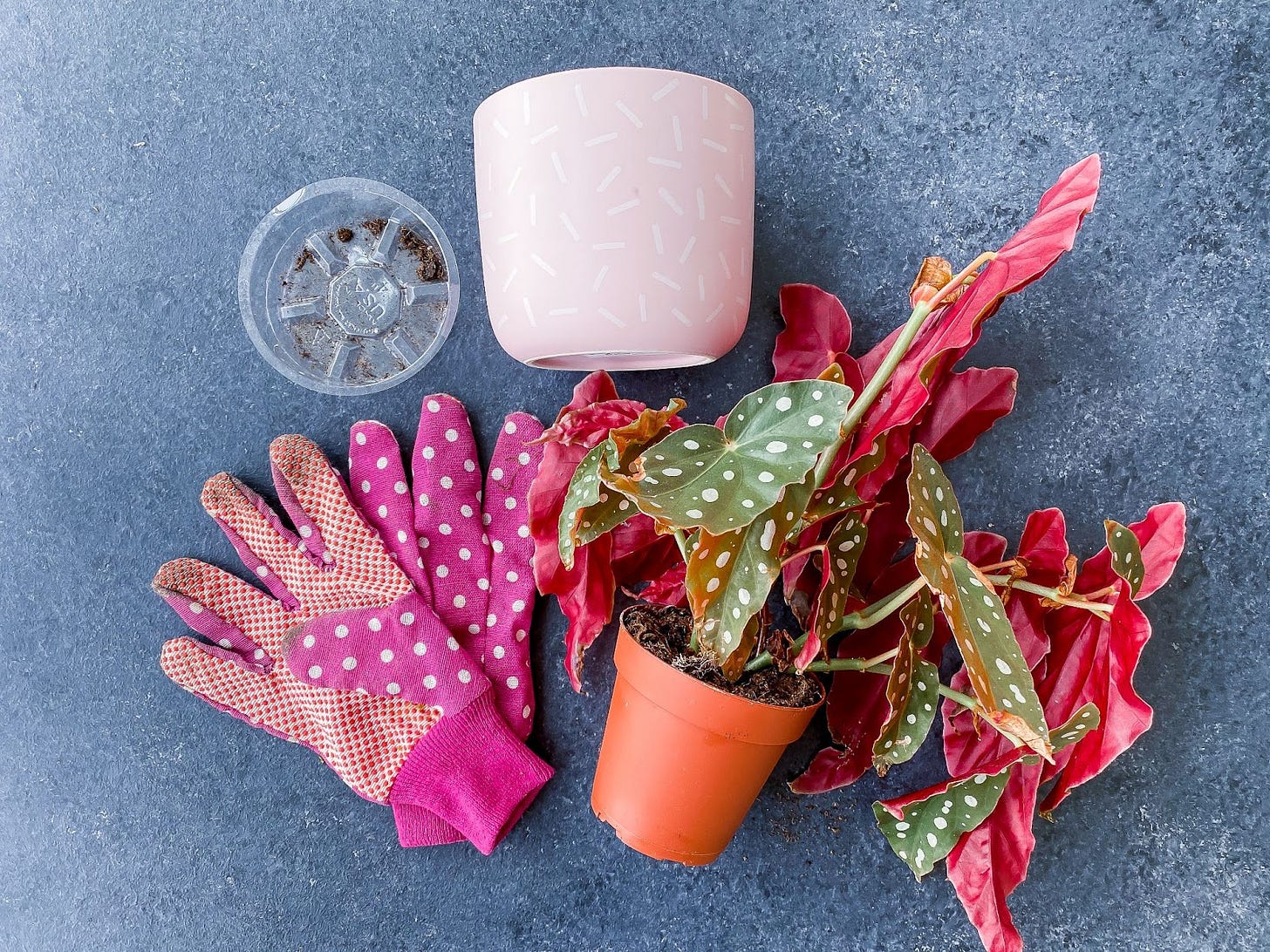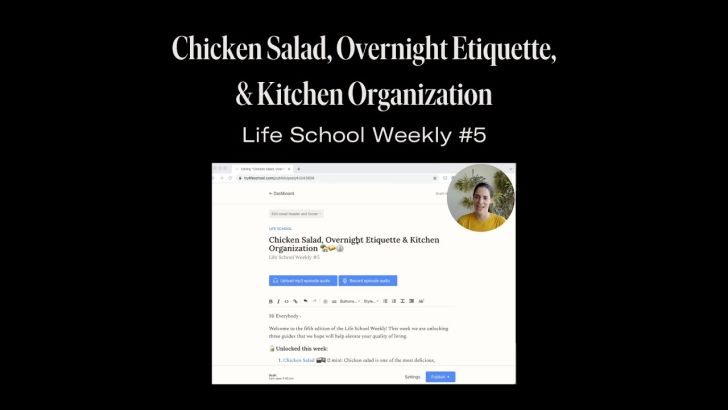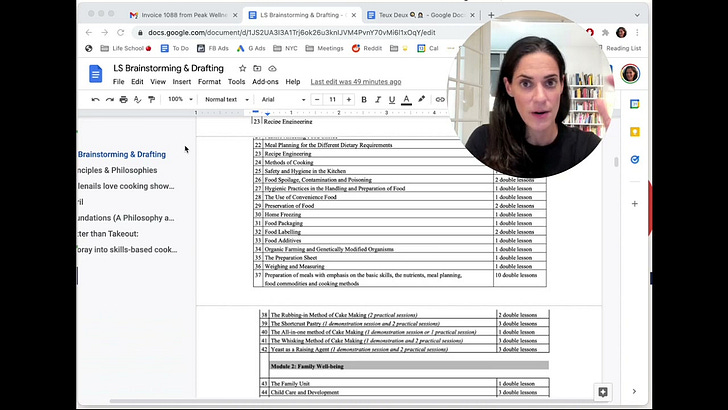This guide is 1,098 words, a 4 min and 23 sec reading time. It was co-written with houseplant expert David Dekevich. To learn more about David check out the partner lesson, The Joy of Indoor Gardening 🎬🌟🎙.
⚡️ TLDR: Water approximately once per week, soak the roots, and ensure the pot has drainage.
📍 Introduction
Indoor gardening is rewarding, fun, and once you get the hang of it, relaxing. Additionally, plants bring nature into the home, help rejuvenate the air, make a room feel cozier, and add a dash of flair at a very low cost.
With a bit of knowledge, anyone can become a proud plant parent. Requiring just light, water, soil, and nutrients, houseplants can survive (and even thrive!) in almost any home.
So take a deep breath and snag that cute succulent you see at the store. As the old saying goes, if you have a window, you can have a plant! 🪴
⚙️ Gear
Required
Plant
Soil
Pot/planter
Optional/recommended:
Saucer/plastic drip tray (like these)
Fertilizer/nutrients (e.g., Miracle Grow)
Watering can
Gardening gloves
📑 Lesson Glossary
Container: also known as a plastic container or nursery container -- what the plant comes in
Pot: also known as a decorative pot: what you put the container/plant in
Root rot: a disease that attacks the roots of plants growing in wet soil
Rootbound: having roots formed into a dense, tangled mass that allows little or no space for further growth
✅ Potting Instructions:
Basic Potting (Nursery container inside a decorative pot)
Ensure plastic nursery container fits inside your decorative pot
If the pot has holes, place a plastic drip tray inside, or saucer underneath
Carefully lower plant into decorative pot & place in new home
Repotting (e.g., into a larger nursery container or decorative pot)
Remove the plant from the container.
If the plant is root-bound (e.g., roots circling plant), loosen roots & soil.
Fill the new container (or a decorative pot with holes) ~25% full with soil.
Place the plant inside & fill in the empty space with soil. Leave ~ 1 inch of space from the top.
Top with pebbles/moss/gravel (optional)
📝 Notes, Tips, and Tricks:
Shopping for Plants & Gear:
Hardware & home supply stores (e.g., Ace, Lowe's, Home Depot) typically carry required gear. Plant shops and nurseries usually have a greater variety of plants and pots.
For unique or one-of-a-kind pots & planters, consider furniture & home goods stores, garage/estate sales, thrift shops, flea markets, & swapping with friends.
Recommended online plant shop: Delano, The Sill, Ansel & Ivy
For rare or exotic plants, check out Etsy and plant groups on Facebook. (Tip: make sure you are buying plants, not seeds)
To save money, consider buying younger/smaller plants as opposed to fully grown ones.
For beginners, fast-growing plants are particularly entertaining. However, they are also likely to outgrow their pots sooner.
Pots & Potting:
Pots are typically for single plants; planters are wider & hold multiple plants.
Pots must have a mechanism for drainage, or the roots will sit in water, leading to root rot. Root rot (the growth of bacteria or fungus around the roots) is the leading cause of early plant death.
A pot should be about 0-2 inches larger than the plant. If too small, the roots crowd & become rootbound, hindering the plant's ability to grow. If too big, there will be too much soil, leading to overwatering and root rot.
Filling the plant too high with soil leads to overflow when watering.
If a pot has holes, you can use a plastic drip tray inside or saucer outside. This will protect surfaces from dripping water. Alternatively, tuck it into a small, rolled-over ziplock bag.
Potting soil works well for most indoor plants. Cactuses & succulents thrive best in cacti mix.
Some plant parents believe that adding a few rocks/pebbles at the bottom helps facilitate drainage. This addition is not required but optional.
A typical rule of thumb is to repot the plant approximately once every two years.
Watering:
Most plants survive on a once-per-week watering schedule. Exceptions include large leafy plants (~ twice/week) and succulents/cacti (~ every three weeks, or whenever completely dried out). Rule of thumb: the more leaves, the more water a plant requires.
The goal of watering is to thoroughly soak the roots without over-filling the pot with water. This takes some practice & over time, you will learn how much water each plant needs.
Before watering, check with a finger to see if the soil is still moist. If so, hold off a few days.
If you have trouble remembering to water your plants, try add a repeating calendar invite (e.g., every Friday at 8 am). For next-level calendaring, put in the low water plants every three weeks, and the higher water plants every week.
Watering in the sink is recommended for a) plants without drip trays, b) new plants c) beginners. To water in the sink: remove plant in nursery container from the pot, soak thoroughly in the sink, let drain & replace.
One trick to avoid overflowing is to go very slowly or in two half-rounds.
Signs of overwatering: drooping, yellowing or browning of leaves, soft or mushy leaves. Signs of underwatering: sad, wilted look, yellowing/browning, crisp & dying leaves.
To promote growth, add some fertilizer to water ~2x/month. Don't feed during the winter.
A watering can help steady the flow of water but is unnecessary. A pitcher, bottle (or any container) works equally well.
In general, plants tend to need more water during summer during their growth periods and less during winter when growth is stagnant.
Other
Most plants thrive best with indirect light, as direct light can burn leaves. However, a few hours of direct sunlight won't hurt most plants.
Try to find plants and pots that call to you. You may have them in your home for decades!
Plants should bring joy. If you fall out of love with a plant, it's okay to let it go (e.g., give to a friend, compost)
If you want to be extra careful, try using a moisture meter. This reusable device detects moisture at the base of the plant where your fingers cannot reach.
Next-level hack: For the most economical (and fun) plant procurement, grab a clipping from a friend. You can propagate it for 4-6 weeks in a jar with water and then plant it. More info here.
📓 Low Maintenance Starter Plants:
Fast-growing: pothos (aka ivy)
Trees: Ficus (fiddle leaf fig, rubber), palm
Low-water: succulents, cactuses, air-plants
🎓 Further Study:
How to Take Care of Plants 🎬 [Life School]
The Joy of Indoor Gardening 🎬🌟🎙 [Life School]
14 of the Fastest Growing Houseplants for a Nearly Instant Indoor Garden
Become an Indoor Plant Parent [NY Times]
How Taking Care of Houseplants Taught Me to Take Care of Myself [NY Times]
It's True—You Really Should Talk to Your Plants [The Spruce]
—
🎳 Lesson Team: Michelle Tandler (Research) & David Dekevich (Plant Expert)
✏️ Did you like this lesson? Loved it! ⭐️ · Pretty good 🤷♂️ · Could be better 😐
🤓 Know anybody who would make a great researcher? We’re hiring!
🎧 Prefer to listen? Subscribe on iTunes, Spotify, or Overcast.
📚 Want to learn more? Check out the bulletin board.










